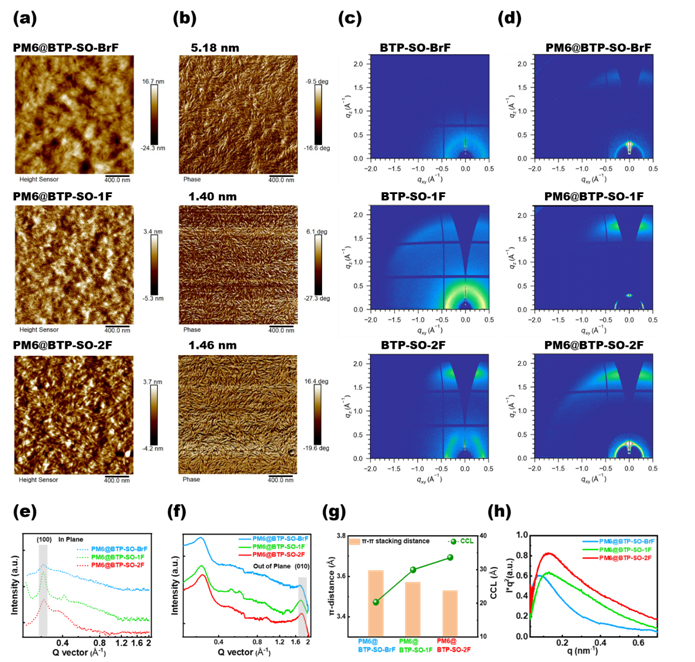
近日,我院海杰峰副教授联合南京理工大学俞江升副研究员、东华大学胡华伟研究员和南京大学陈尚尚教授在绿色高效有机太阳能电池研究方面取得最新成果,在知名期刊Chemical Engineering Journal(SCI一区TOP期刊,IF=16.744)上发表题为“Ending group modulation of asymmetric non-fullerene acceptors enables efficient green solvent processed organic solar cells”的研究论文。该项研究工作得到广西自然科学基金(2022JJA120094)、广西电磁化学功能物质重点实验室开放基金(EMFM2022101)和广西高校中青年教师科研基础能力提升项目(2022KY0256)等多个项目的资助。
基于非富勒烯受体(non-fullerene acceptor, NFA)的有机太阳能电池(organic solar cells, OSCs)虽然已经取得了长足的进步,光电转化效率(power conversion efficiency, PCE)超过了19%,但是在实现其商业化的道路上,为克服传统工艺使用有害的卤代溶剂,而采用绿色溶剂制备工艺(green solvent processed, GSP)获得高效的OSCs仍然极具挑战。因此,探索开发适用于高效GSP-OSCs的新型NFA材料变得尤为必要。
海杰峰副教授研究团队合成了系列不对称NFA分子(BTP-SO-BrF, BTP-SO-1F, BTP-SO-2F),它们拥有相同的烷氧基/烷硫基支化侧链,不同的吸电子端基(IC-BrF, IC-1F, IC-2F)。不对称的烷氧基/烷硫基支化侧链修饰极大提升了此类NFA分子在绿色溶剂中和聚合物给体材料PM6的相溶性。端基调控作用表明,与另外两类材料(BTP-SO-BrF, BTP-SO-1F)相比,基于PM6:BTP-SO-2F的共混膜展现出更紧密的分子间堆积距离、更合适的纤维状相分离形貌以及更均衡的载流子迁移率。最终,基于PM6:BTP-SO-2F的优化器件,其PCE达到17.6%,明显高于基于PM6:BTP-SO-BrF和PM6:BTP-SO-1F的器件效率(15.5%和16.2%),这也是目前文献报道绿色溶剂制备基于不对称NFA的OSCs的最高效率。这项工作展示了端基工程实现对NFA的形貌调控从而获得绿色高效OSCs的先进策略。
全文链接:https://www.sciencedirect.com/science/article/pii/S1385894723009099?via%3Dihub

Figure 1. Table of content

Figure 2. (a) Schematic diagram of GSP-OSC devices. (b) The J-V curves of three groups of optimal GSP-OSCs. (c) EQE curves of GSP-OSCs. (d) The plot of PCE versus VOC for representative green non-halogen solvent processed binary OSCs based on symmetric/asymmetric NFA. (e) Photoluminescence quenching spectra of the neat PM6 and three blend films. (f) Jph vs. Veff curves, (g) JSC vs. Plight curves, (h) VOC vs. Plight curves. (i) Histogram of the hole and electron mobilities of PM6:NFA-based devices.

Figure 3. AFM (a) height and (b) phase images (2 μm × 2 μm) of the blend films based on PM6:BTP-SO-BrF, PM6:BTP-SO-1F, and PM6:BTP-SO-2F. 2D GIWAXS patterns of (c) three neat NFA films and (d) three blend films. The corresponding 1D GIWAXS line-cut profiles of the (e) in-plane (in dashed) and (f) out-of-plane (in solid) directions of three blend films. (g) π-π stacking distance and CCL out-of-plane π-π peak of three blend films. (h) Lorentz-corrected RSoXS profiles of three blend films.